Feds Set the Rules on American Rescue Plan Spending

It’s been two months since Congress passed the $1.9 trillion stimulus bill known as the American Rescue Plan Act (ARPA). But state lawmakers have not been able to make any decisions on how to spend the aid.
That changed Monday, May 10, when the U.S. Department of the Treasury published a 151-page set of rules governing how state and local governments can use the money.
It’s a lot of money. Colorado will receive $3.8 billion for the state government and $1.9 billion for county and city governments. Treasury’s guidance seems to aim for maximum flexibility and simplicity in how state and local governments can use the funds — good news for legislators, county commissioners, and city leaders.
First, some context. The ARPA had few details on how the stimulus money could be spent, because bills passed under the reconciliation process aren’t allowed to have many policy prescriptions. That’s why guidance from federal agencies is so important.
The federal government will issue many guidance documents for the ARPA, but this week’s release from the Treasury was the big one for state and local governments. Further important guidance in public health will come from the Centers for Disease Control and Prevention, covering the ARPA’s $7.7 billion for the public health workforce nationwide.
There’s still a lot for public health leaders to digest in the new Treasury guidance for state and local governments. Here is an overview of the guidance, with an emphasis on health provisions.
Congress said the ARPA’s state and local money can be used for four broad purposes:
- Responding to the COVID-19 health emergency and its economic effects. This category covers most public health funding in the ARPA’s state and local sections.
- Providing extra pay for in-person essential workers. Both public and private employees in sectors like health care, grocery stores, warehouses, and schools would be eligible, but policymakers don’t appear to be obligated to offer premium pay.
- Restoring government services that were cut when tax revenues crashed. The guidance gives states a formula to calculate how much revenue they lost. The state can spend money in this pot for almost any purpose, except for debt service or filling a pension fund. State legislators are most keenly interested in this section.
- Investing in water, sewer, and broadband infrastructure. The guidance says broadband projects should provide underserved areas with internet service of at least 100Mbps. That’s around the average speed in Colorado but much faster than is available in many rural communities. Congress included water and sewer projects because of their importance to public health.
State policymakers can decide how much money — if any — to put into each of the four areas. They also have until the end of 2024 to start projects using the money. All the dollars must be spent by the end of 2026.
The first purpose — responding to COVID-19 — holds the most promise for public health. Treasury’s guidance takes a long view of the effects of COVID-19 and allows spending on projects that could be beneficial even after the pandemic ends, including improving disease surveillance, health data systems, and public communications.
A few health policy highlights from the COVID-19 response section of the guidance for state and local governments:
- Health equity. The guidance encourages states to address health disparities by paying for community health workers and health navigators, funding affordable housing, removing lead paint, and implementing evidence-based violence prevention programs. Cities, counties, states, and tribal governments will have broad discretion to spend the money to address disparities in low-income census tracts. They can also target spending on communities that suffered disproportionately from the pandemic. The 2021 Colorado Health Access Survey, to be released this year, could provide valuable data in both targeting and justifying ARPA spending.
- Education and early childhood. Allowable spending includes new or expanded early learning and child care, tutoring, and after school and summer school programs.
- Behavioral health care. The pandemic will have long-lasting effects in this area, so the guidance allows spending on mental health and substance use treatment and prevention, plus services to promote access to care.
- Public health payrolls. Health departments can be reimbursed for the portion of their employees’ time spent on COVID-19.
This blog post is a brief summary of the guidance. The guidance document itself should be required reading for anyone in a decision-making position. Also, the Joint Budget Committee staff has prepared a useful memo on what the guidance means for the state legislature.
This infusion of money is a rare opportunity for Colorado’s state and local governments. The new Treasury guidance gives policymakers plenty of options for how to use the money. We at CHI think Coloradans can work together to craft creative, evidence-based, and effective ways to improve well-being across the state, and we are ready to help.
Related Blogs and Research
- Colorado State Budget Has Dollars to Spare
- Mapping Federal Funds for COVID-19 Relief
- In Words and Actions, Biden Sets a New Tone
CHI's work on rapid analysis of current policy challenges is made possible by The Denver Foundation.


